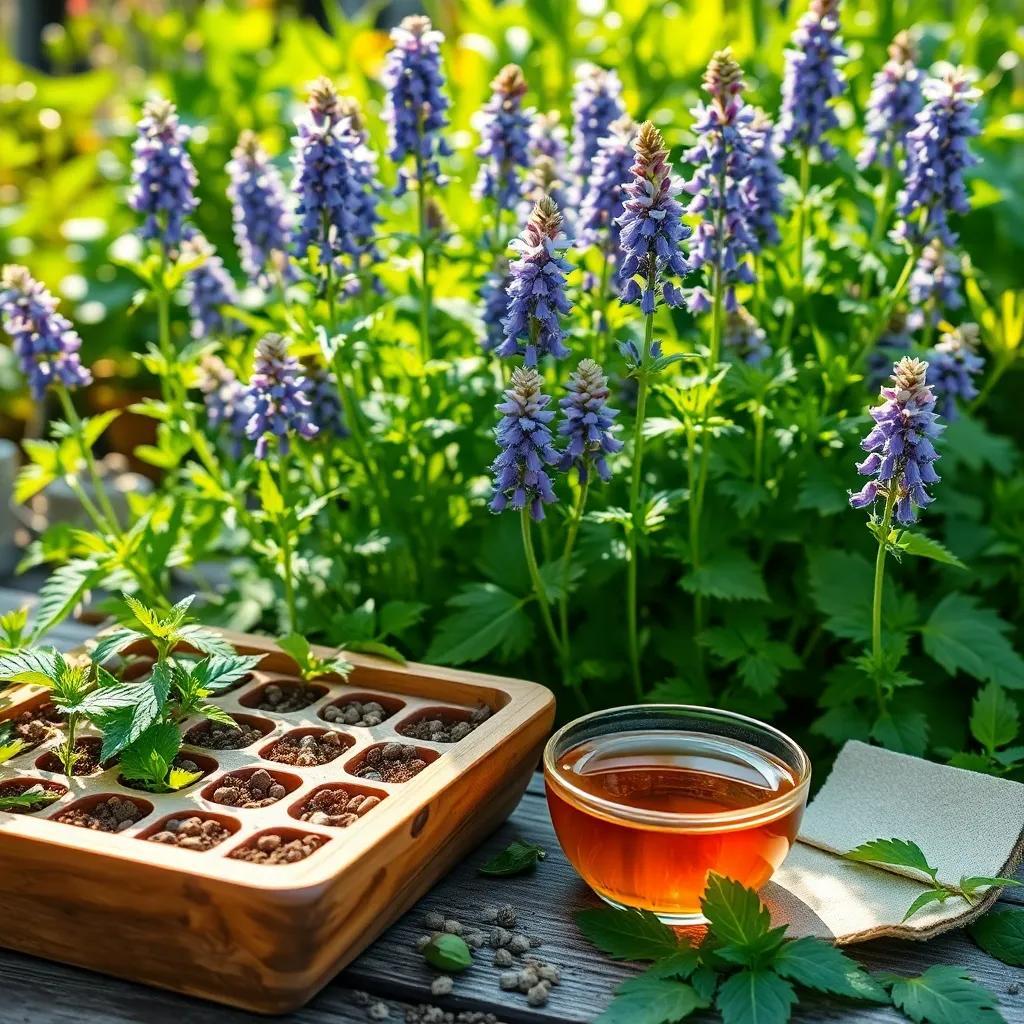Are you ready to grow your very own catnip garden? It’s not just for our furry friends; catnip is a delightful herb that can brighten up your home and even offer some fun in the kitchen! Join me as we explore the amazing world of catnip, from its enchanting effects on cats to the simple steps for planting and caring for this wonderful plant!
Understanding Catnip and Its Uses
Catnip, or Nepeta cataria, is a delightful herb from the mint family that brings joy not only to cats but also to many humans! If you have a feline friend, you might already know about the magical effects catnip can have. It’s like cat candy! When they sniff it, you might see them rolling around, purring, and acting like they’ve just discovered the best toy ever. Did you know that about 50-75% of cats respond to catnip? It’s a fun little inheritance from their ancestors!
But catnip isn’t just for our furry pals! This fabulous herb has a history rich in traditional medicine. For centuries, people have used catnip leaves and flowers to make teas that help with anxiety, insomnia, and even some digestive troubles. Imagine a soothing cup of catnip tea after a long day! It’s like a gentle hug for your insides.
Cooking with catnip can be a delightful experience too! While not a common ingredient, this herb can add a touch of minty goodness to things like herbal teas, salads, and even sauces. It’s versatile and adds a unique flavor profile to dishes. Growing catnip in your garden means you can experience all its benefits, from its effects on your cat to the tasty treats you can whip up for yourself!
So, now that we know how awesome catnip is, let’s talk about how to take the next step and prepare those little seeds for planting. Getting into the action of growing catnip is just as exciting as watching your kitty bounce around!
Preparing Catnip Seeds for Planting
Before planting your catnip seeds, it’s important to get them ready! Think of it as giving them a little pampering before they start their journey to becoming lovely plants. Here are a few steps to follow:
- Scarify the Seeds: This sounds fancy, but it’s quite simple! Gently scratch the outer coat of the seeds. You can use fine-grit sandpaper or soak them in warm water overnight. This helps moisture get in and kickstarts the germination process!
- Choose Your Planting Method: You can plant your seeds indoors in seed trays or start them directly in your garden. If you decide to go the indoor route, use a seed-starting mix that drains well. Just pop one or two seeds into each container and cover them lightly with soil.
- Find the Right Spot: Whether indoors or outdoors, make sure your catnip is getting some love in the form of sunshine! Catnip enjoys being in the sun, so pick a spot that gets at least 6 hours of sunlight daily.
- Moisture is Key: Keep the soil consistently damp but not soggy. Think of it as giving your seeds a nice little spa treatment! Just a sprinkle of water here and there should do the trick.
- Temperature Matters: Aim for a cozy temperature between 60 to 70°F (15 to 21°C). If it’s too chilly, your seeds might not sprout, and we don’t want that!
By preparing your catnip seeds properly, you’ll be well on your way to growing a garden full of this delightful herb! Remember, a little patience and care can go a long way. Happy planting!

Step-by-Step Germination Process
Germinating catnip seeds is a fun and easy process! Once you’ve prepared your seeds, it’s time to get things sprouting. Let’s break it down step-by-step to make sure your catnip grows strong and healthy.
- Sow the Seeds: If you haven’t already, plant the scarified seeds in a container filled with a well-draining seed-starting mix. I like to use small pots or seed trays, but you can choose what works best for you. Place one or two seeds in each container and cover them gently with a thin layer of soil. Just remember, they don’t need to be buried too deep!
- Water Wisely: Give the soil a light watering after sowing the seeds. Be careful not to overdo it! The goal is to keep the soil moist, but not soaked. A gentle spray from a misting bottle usually does the trick, helping to avoid displacement of the seeds.
- Create a Cozy Environment: Catnip seeds love warmth, so keeping them in a warm spot is key. Try placing them on a sunny windowsill or using a heat mat. Just make sure the temperature stays between 60 to 70°F (15 to 21°C).
- Light or Dark?: Catnip seeds can germinate in both light and darkness. If you prefer light, just cover them lightly with soil and expose them to the sun. If you cover them with plastic to keep humidity in, remember to remove that cover once sprouting begins!
- Wait for Germination: Patience is a gardener’s best friend! Most catnip seeds will germinate within 7 to 14 days. Just keep an eye on them and ensure the soil stays damp. You might see a little green peeking through in no time!
Once your seeds have germinated and grown into adorable little seedlings, you’re ready to move on to the next stage: caring for them as they grow!
Caring for Germinated Catnip Plants
Now that you have those lovely catnip seedlings, it’s time to give them some TLC! Think of it as nurturing a little bundle of joy in your garden. Here’s how to keep your catnip plants happy and healthy:
- Sunshine is Key: Place your seedlings in a spot that gets at least 6 hours of sunlight each day. If you’re growing indoors, a sunny windowsill or using grow lights can make a big difference. Catnip loves light almost as much as cats love to chase strings!
- Water Smartly: Keep the soil consistently moist, but be careful not to drown your plants. Water them deeply when the top inch of soil feels dry. Just think of it as giving your plants a good drink after a long day!
- Space it Out: When your seedlings have grown a few inches tall and are ready to be transplanted, make sure to give them room to breathe! Space them about 18 to 24 inches apart. This allows proper airflow and prevents overcrowding, which can lead to unwanted issues.
- Fertilize Sparingly: While catnip doesn’t need a lot of fertilizer, a little organic compost or a balanced slow-release fertilizer can give it a boost. Just avoid too much nitrogen since it might result in more leaves and less of that fun aroma.
- Pest Watch: Catnip is pretty resistant to pests, but it’s good to keep an eye out for any uninvited guests like aphids or spider mites. If you spot any, try natural pest control methods like neem oil or insecticidal soap.
With a little care and attention, your catnip plants will thrive! Soon, you’ll have a delightful garden full of wonderful herbs for you and your feline friend to enjoy.
Common Challenges and Solutions in Cultivation
Growing catnip can be a rewarding experience, but sometimes we face a few bumps along the way. Here are some common challenges you might encounter and how to tackle them like a pro!
- Poor Germination Rates: If your seeds aren’t sprouting, it might be due to low-quality seeds or improper conditions. Make sure you are using fresh seeds from a reliable source. Remember that soaking and scarifying the seeds can improve your chances of success!
- Damping Off: This is a term used to describe when seedlings suddenly wilt and die, often due to overly wet soil and fungal infections. To prevent this, ensure your soil is well-draining and avoid overwatering. Also, try to keep the seedlings in a warm, airy environment.
- Leggy Seedlings: If your seedlings look tall and spindly, they may not be getting enough light. Move them to a sunnier spot or increase the exposure to grow lights. Cats are playful, but your seedlings need strong stems to stand up tall!
- Pest Problems: As I mentioned, catnip is generally resistant to most pests, but aphids and spider mites can still show up. Keep a close eye on your plants! If pests appear, try introducing beneficial insects like ladybugs or using a simple mixture of water and mild soap to wash them away.
- Environmental Stress: Changes in temperature or humidity can stress your plants. Try to maintain a consistent environment. If growing outdoors, be prepared to provide some shade during extremely hot days or protection during a cold snap!
By anticipating these challenges and having a plan in place, you can increase your chances of a successful catnip garden. Enjoy the journey, and happy growing!

